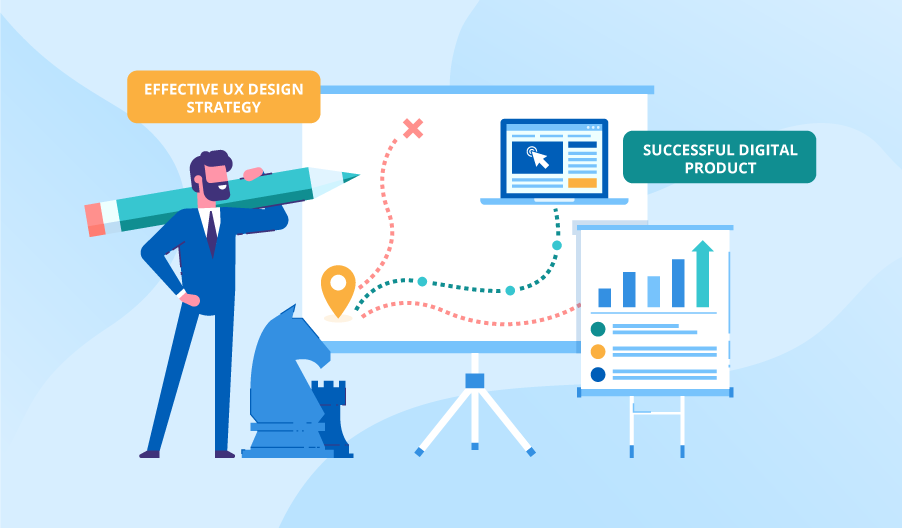How to Build an Effective UX Design Strategy
Editor’s note: In this article, Anastasia shares ScienceSoft's methods of creating a UX strategy for digital products, enterprise applications, and ecosystems and gives useful advice on the strategy design process. To see how an ample UX strategy will benefit your project, try out our UX design services.
If you’re reading this post, then you’re probably already aware of the importance of user experience. You know that the professional UX design approach decreases more than a half of the developers’ efforts on pre-production issue fixing and that a quality UX design can bring as much a 4x – or, as one of ScienceSoft’s projects proves – up to 6x increase in conversions.
Below I’ll zero in on how exactly you can make sure you have the right UX approach and the quality UX design by devising the right user experience strategy.

What is a UX strategy
Like any strategy, user experience strategy is about knowing your current stance, your future goals and the steps in between. So it makes sense to broadly define the term as a plan that helps you get from the UX you have to the UX you want to have in the most effective way.
Key Performance Indicators (or KPIs) are an indispensable part of a UX strategy and deal with your goals in more specifics. For instance, they give the exact number to the revenue increase you want or name the bounce rate you are ready to tolerate.
Apart from KPIs, any UX strategy relies on and requires gathering the following data:
- Needs and expectations of the target users.
- Conditions and interests of the stakeholders.
- Objective technical capabilities.
A good UX strategy also implies a definite set of priorities, individual for each business. ScienceSoft always tells clients that they should concentrate on achieving UX goals with the highest impact on their business first and, thus, have to be prepared to make sacrifices – such as put some features in the backlog or narrow down the target audience.
How to design a UX strategy
Depending on the client’s digital project, a UX strategy can entail more specifics as to what steps to take and what to focus on. Therefore, l’ll talk about building a UX strategy for the two major types of projects separately.
UX strategy for a software application
Years of cooperation with the clients who want a software application to be the main touchpoint with their customers allowed ScienceSoft to see a pattern in the challenges these businesses experience. Focusing on this software solution – either still planned or already developed – business owners quite naturally want to get the best of it. They try catering to the widest target audience and cover as many user tasks as possible.
Such a mindset creates difficulties for making any sacrifices. The consequences of this vary but are equally uninspiring. Before turning to ScienceSoft for UX consulting, some of clients had a roadmap that exceeded the stakeholders’ time and financial plans by 150-200%. Others were simply so overwhelmed with the needs and expectations of all their target users that they got stuck in the choice paralysis.
ScienceSoft's approach:
Although the wish to target a wider user base is understandable, ScienceSoft always reminds clients that complying with the requirements of too many users can cause feature creep, which can ruin the user experience and lead to losing rather than gaining users. Here’s one of the customer stories as a forewarning.
Before reaching out to ScienceSoft, a client performed 5 planned updates to their document management product over the period of 6 months. All updates gradually introduced new features, requested by a number of users, who belonged to what the client believed to potentially be a new profitable audience. But since they started to introduce the new features, the client saw a significant decline in their existing userbase.
Our audit uncovered that over 75% of the indeed profitable potential audience was already using 2 types of powerful document management products catered specifically to their needs. In short, the new functionality of the client’s product was insufficient to attract a new target audience and repelled a large share of the existing user base because of the emerged hurdles in navigation that slowed the work processes down.
A thoroughly planned and timely applied UX strategy could have helped this client to realize that:
- despite occasional user requests, a large share of the new target audience was content with another powerful product,
- the newly introduced basic features wouldn’t be enough to win the new target audience over,
- the newly introduced features could be hindering enough to make a sensible percentage of the core user base migrate to a less overwhelming solution with better UX.
To prevent such situations, it's important to leverage custom UX strategies that focus on a client’s individual business goals and define key user audiences that will enable achieving them. The effectiveness of such a UX strategy also lies in making very detailed personas that help grasp how exactly a software product is or will be perceived on the market. The situations where a software application leaves a target audience unimpressed can be avoided only this way.
UX strategy for a customer’s journey
The other type of ScienceSoft's clients requesting UX consulting are the companies with multichannel customer communication. A range of touchpoints – including a website, mobile app, presence on marketplaces (Amazon, eBay) and social networks (Facebook, Instagram) – give such businesses wide exposure. But even though they succeed in attracting different audiences, their user satisfaction and conversion rates are lower than expected.
From our experience in auditing such clients, it's clear that the reason for their business underperformance is the lack of coherent UX. Despite reaching out to customers in a number of ways, these businesses have yet to unite their multiple touchpoints into a single customer journey that brings customer loyalty and high ROI.
ScienceSoft approach:
Most companies see touchpoints as single entities that are difficult, if not impossible, to unite, and this belief stems from the internal view of touchpoints as a combination of a responsible company department and allocated budget. A user, however, simply has needs or goals and just as they don’t think of purchasing something as “conversion”, they don’t think of the ways to achieve their goals as “touchpoints”.
Understanding how a user perceives each touchpoint is what makes for a successful UX strategy for a customer journey. To achieve this, it's important to create multiple user scenarios that open all the possibilities of having various touchpoints intertwined. With aligned UX, a bunch of seemingly independent digital touchpoints turns into an entire ecosystem that becomes a true customer companion. It guides a customer on every step of their digital journey, suggesting pre-selling consultations, post-purchase support, as well as up-/cross-selling in the personalized, natural and, therefore, effective way.
To get a better idea of what a cross-channel customer journey with coherent UX feels like, take a look at ScienceSoft’s B2C ecommerce demo that shows the powerful benefits of the interconnected touchpoints.
Who should take part in the UX strategy design
As you can see, an efficient UX strategy always relies on the data from in-depth business analysis and planning. That’s why the team working on UX strategy design should involve either of these combinations:
- A business analyst with professional UX design experience.
- A UX expert with business analysis expertise.
- A BA and a user experience expert, who contribute equally.
In case of designing UX for a customer journey, it's also worth adding product managers responsible for different touchpoints to the team. They can offer valuable input on touchpoint specifics and contribute to the vision of an ecosystem.
It’s always a good time to make your project more profitable
Creating a UX strategy for a planned software application or customer journey is just as effective as applying it to the already existing ones: it’s never too late to stop and think why your digital project doesn’t do as well on the market as you think it deserves to. By preparing a distinct UX roadmap, you make sure investment in your project’s wide adoption, customer loyalty, and a high return on investment. In case you need more detail on devising a UX strategy or want a UX consultation, feel free to contact our UX team.

